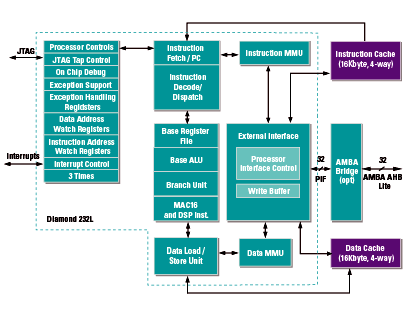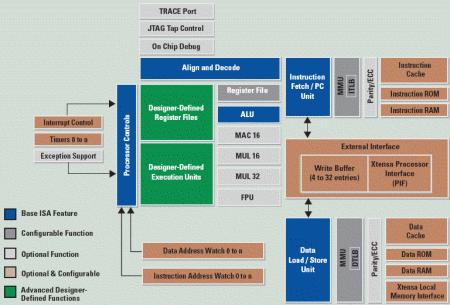Configurable processors gain Linux support
Jun 2, 2008 — by Eric Brown — from the LinuxDevices Archive — 4 viewsConfigurable processor manufacturer Tensilica announced that its ultra low-powered “post-RISC-based” processors are now supported by two Linux development partners. The ARM9-like Diamond Standard and ARM7-like Xtensa7 chips will gain a custom Linux implementation from Embedded Alley (EA), and pre-built binary software and support subscription services from TimeSys.
Both chips are based on Tensilica's “Xtensa” architecture, which supports 32-, 24-, and 16-bit instructions, with modeless switching. When possible, Xtensa uses shorter instructions to reduce power consumption and boost code density, says Tensilica, in a way that is similar to ARM's 16-bit “Thumb” and Thumb-2 instructions. Xtensa also features “register windows,” which it says provides for efficient procedure switches.

Tensilica Diamond Standard 232L architecture
According to Tensilica, “open-source Linux is the target operating system” for the Diamond Standard 232L, which it bills as “the industry's smallest, lowest-power licensable 32-bit core that supports Linux.” Touted as having better performance than ARM's successful ARM926EJ-S core design, the 232L was specifically designed to run Linux. It offers an MMU (memory management unit), and 16KB each of four-way associative instruction and data cache. The part has been supported by MontaVista with an optimized version of MontaVista's Linux Professional Edition, and in December, Tensilica announced a deal with fabless ASIC vendor eASIC, giving the latter's customers “free access” to Tensilica cores and DSPs, with no mask charges or minimum orders.

Xtensa 7 architecture
(Click to enlarge)
The new arrangements with EA Solutions and Timesys also extend to Tensilica's Xtensa 7 core, which targets deeply embedded applications, such as embedded control and digital signal processing. In its most basic configuration, it compares to ARM's ARM7TDMI-s cores, albeit with more performance and lower power, Tensilica claims. The Xtensa 7 core is also available with MontaVista Linux, which includes tools aimed at helping designers configure interfaces, memory subsystems, and other components, and even extend the architecture with application-specific instructions programmed in C/C++.
New support options
Tensilica is joining the Silicon Vendor Partner Program that was recently established by professional services and consulting firm EA Solutions. EA, in turn, will produce a customized embedded Linux development and runtime environment called a “Platform Optimized Linux Solution” (POLS) for the Tensilica processors.
In addition, Tensilica hardware platforms have been added to the EA Solutions automated test lab for regular regression testing, and the company will also maintain the Xtensa-architecture optimized components, kernel, and tools in the community source trees. In addition, EA Solutions will support the processors with Linux consulting services and training.
The Timesys LinuxLink subscription for Tensilica will provide developers with “a complete embedded Linux platform” that is optimized for the Diamond Standard and Xtensa processor families, says Timesys. Due to ship in July, the web-based subscription will include an optimized kernel, drivers, toolchain, and initial root filesystem. The subscription will also include Timesys Timestorm, an Eclipse-based integrated development environment (IDE) for streamlining kernel and root filesystem configuration, profiling, testing, and debugging tasks.
Stated Steve Roddy, Tensilica's VP of marketing, “We've seen strong demand for open-source Linux support.”
Stated Greg Quiggle, VP of sales and marketing for Timesys, “Adoption of Tensilica processor cores is growing steadily within major electronics companies, with several requesting open source Linux support.”
Stated Pete Popov, EA Solutions's president and CEO, “As more deeply embedded devices are embracing the Linux operating system, the device makers are embracing Tensilica's low-power, high-performance processor cores. Particularly compelling is Tensilica's unique ability to combine leading edge DSP features, such as the market leading HiFi2 Audio engine DSP, with a Linux-compatible MMU in one core configuration.”
Availability
The Timesys LinuxLink susbscription for Tensilica processors will be available in July, says Timesys, but EA Solutions provided no timetable for its own Tensilica support. According to Tensilica, Embedded Linux 2.6 and GNU tools based on GCC 4.2 for its processors are both available at its Linux on Xtensa developers site.
This article was originally published on LinuxDevices.com and has been donated to the open source community by QuinStreet Inc. Please visit LinuxToday.com for up-to-date news and articles about Linux and open source.